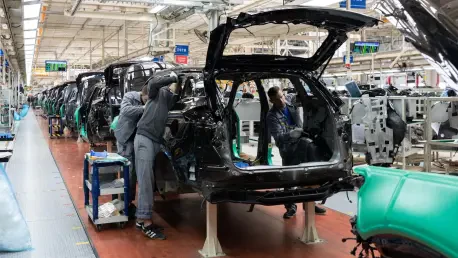The transportation landscape within the U.S. automotive logistics industry is poised for a potential shift with discussions surrounding the merger of Union Pacific (UP) and Norfolk Southern (NS), two major Class I railroads. This merger promises to create a transcontinental freight powerhouse, extending an estimated 52,000 miles and offering streamlined logistics solutions. Such a significant change provides the automotive sector with opportunities for improvement but introduces questions and challenges. The current dynamics of automotive logistics, characterized by its complexity and regulatory frameworks, set the stage for this pivotal event.
U.S. Automotive Logistics Dynamics
Current State and Scope
The automotive logistics industry plays a critical role in transporting vehicles and parts across the nation, heavily relying on a blend of rail, road, and maritime segments. Analyzing the sector unveils key market players, such as cargo carriers and logistics providers, who leverage cutting-edge technologies like automation and AI to refine operations. This segment’s seamless operation is vital, affecting production cycles and delivery timeliness, which are essential to robust economic activity within the nation.
Regulatory Environment
Within the U.S., automotive logistics operates under stringent regulations designed to ensure efficient, safe, and eco-friendly transport. Compliance requirements enforced by agencies such as the Environmental Protection Agency (EPA) and Occupational Safety and Health Administration (OSHA) influence not only the methodologies but also the technologies used by industry players. These regulations demand countermeasures against emissions and mandate safety protocols, shaping every logistic strategy deployed.
Benefits and Opportunities of Merger
Streamlining Logistics
The proposed merger stands to simplify intricate logistics processes currently bogged down by multiple handoffs across rail networks. Harmonizing UP and NS’s extensive rail systems could enhance service consistency and reliability, eliminating current bottlenecks at operational junctions. Such alignment would streamline coast-to-coast rail operations, promising reduced transit times and bolstered delivery schedules — a boon to the automotive industry’s supply chain.
Economic Impact and Cost Savings
By consolidating operations, UP and NS anticipate enhanced operational efficiencies, translating into tangible cost savings for automotive original equipment manufacturers (OEMs). Unified logistics processes can optimize resources through reduced fuel consumption and streamlined labor functions. This merger offers the potential for a pivotal shift toward competitive pricing structures, fostering increased economic activity and fortifying the rail infrastructure.
Challenges and Risks Post-Merger
Regulatory Scrutiny and Monopolistic Concerns
The merger must navigate the regulatory maze of the Surface Transportation Board (STB), which ensures fair competition and guards against monopolistic behavior. Given the already concentrated market with limited players, this merger may face significant scrutiny to prevent a single entity from commanding excessive influence. Although parallels are drawn with past mergers, the STB must balance existing industry dynamics with consumer and client needs effectively.
Market Dynamics and Client Relations
While the merger opens avenues for improved services, it risks disruption through client dissatisfaction and retaliatory actions from competitors. Industry observers speculate on the ripple effects, projecting shifts in client-company relationships within the market. Competition remains crucial, as lower diversification may grant disproportionate leverage to merged entities, impacting market choices for logistics solutions.
Regulatory Considerations
Role of the Surface Transportation Board
The STB exercises its mandate by meticulously reviewing proposed mergers to safeguard healthy competition. Their scrutiny involves evaluating the merger’s potential impacts on pricing, service quality, and market health. In handling mergers like UP and NS, the STB must adjudicate between fostering growth and ensuring consumer protection, steering the strategic direction for logistics evolution.
Compliance and Anti-Trust Measures
U.S. authorities enforce anti-trust measures aimed at maintaining market balance, ensuring that no entity gains excessive control. The importance of these measures rises significantly during mergers, as they need clear demonstration of improved services without compromising consumer choices or ballooning prices. Compliance mandates underscore ongoing requirements for transparent and fair operations.
Future Prospects of Automotive Logistics
Emerging Trends and Technologies
Automotive logistics faces a transformative journey spurred by emerging technologies such as electric vehicles, autonomous transport, and smart infrastructure. These advancements signal possible restructuring within logistics practices, changing paradigms for transportation efficiency, sustainability, and integration, simultaneously ushering in novel market disruptors.
Growth Opportunities and Consumer Preferences
New growth areas in automotive logistics emerge in response to evolving consumer preferences focused on time efficiency, environmental consciousness, and cost-effectiveness. Economic conditions, consumer demands, and technological innovations jointly tether these growth trajectories, providing a roadmap for adaptive strategies within the sector.
Strategic Conclusions
The merging of Union Pacific and Norfolk Southern outlines a potential to redefine automotive logistics by fostering streamlined operations and reducing costs, though tempered by monopolistic concerns. As the industry navigates regulatory scrutiny, the STB’s role remains pivotal in ensuring fair competition within the rail logistics market. Future growth rests on harmonizing technological innovations with consumer needs and economic conditions, marking strategic opportunities for stakeholders in the industry. Insights from ongoing discussions will guide next steps, fostering a landscape that remains dynamic and responsive to challenges ahead.









